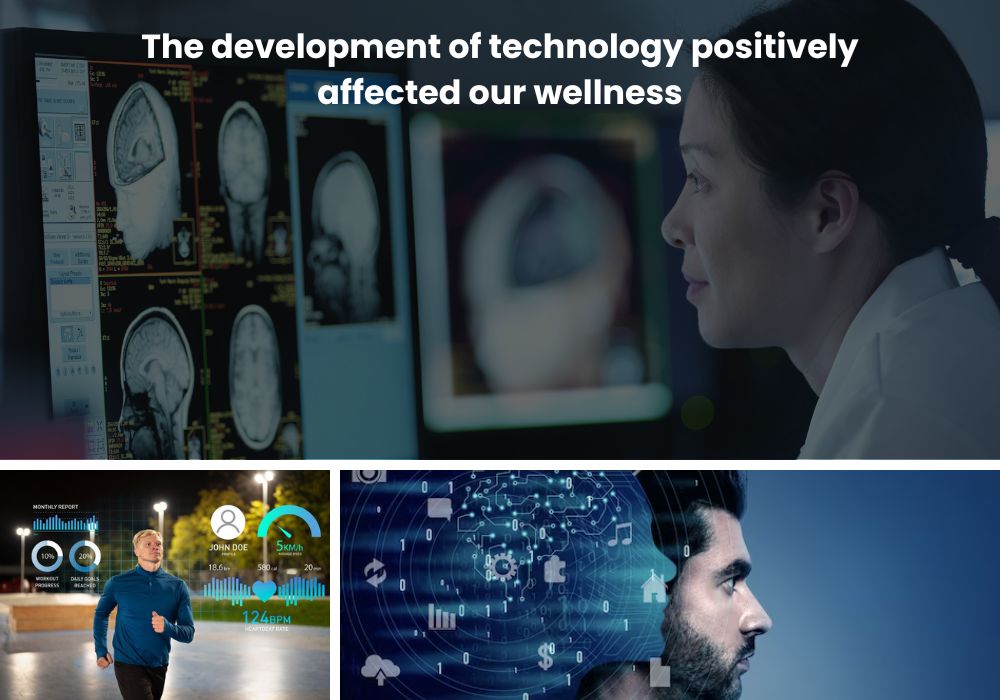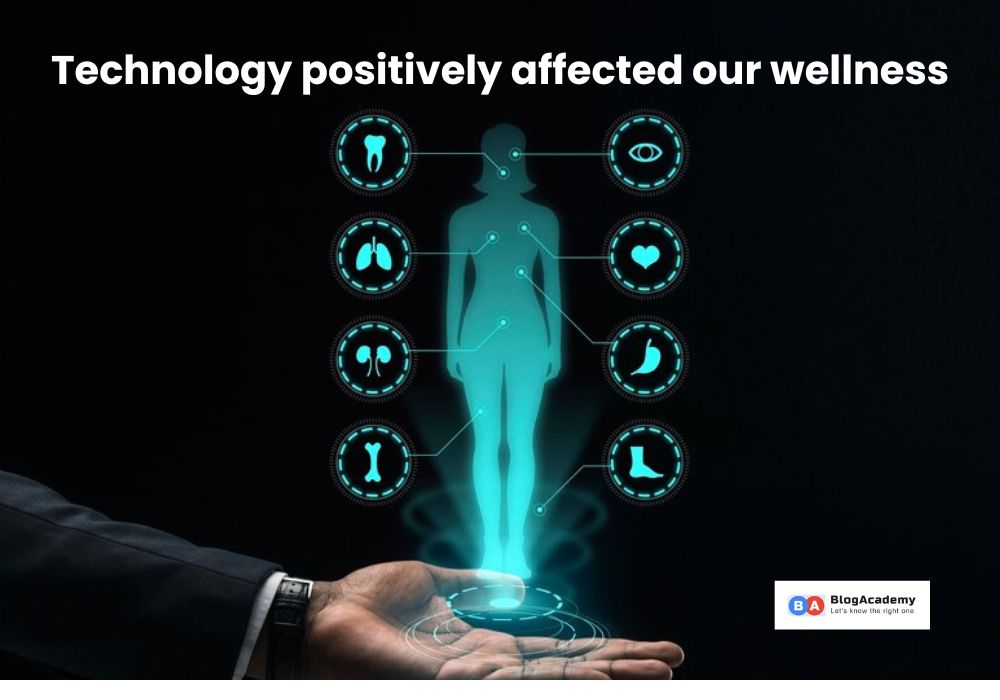Discover how this technology positively affected our wellness. Explore the impact of innovative solutions on our well-being. In today’s fast-paced world, technology has become an integral part of our lives, influencing nearly every aspect, including our wellness.
While it’s true that technology is often criticized for causing stress, anxiety, and other negative impacts, it has also brought about remarkable positive changes in our overall well-being. In this blog, we will explore how technology has positively affected our wellness, providing real-world examples to illustrate these benefits.
In our previous blog post, we discussed How social media affects mental health it can help you explore how social media affects mental health.
In this blog, we’ll delve into the ways technology has positively affected our wellness, exploring its transformative impact on our physical, mental, and emotional health. Join us as we uncover the remarkable ways in which technology has become a catalyst for a healthier and more fulfilling life.
How is the development of technology positively affected our wellness?
The advancement of technology has significantly bolstered wellness across various spheres. In healthcare, technological innovations like telemedicine and wearable health devices have improved accessibility to medical services, monitoring health metrics, and delivering timely care, enhancing overall well-being.
Additionally, fitness and wellness apps offer personalized guidance, promoting healthy habits and physical activity. Mental health support has expanded through online therapy platforms, fostering accessibility and breaking down barriers to seeking help.
Furthermore, technology facilitates social connections, reducing isolation through social media and communication tools. Automation and AI streamline tasks, relieving stress and creating more leisure time.
Overall, technology has revolutionized wellness by providing tools for better healthcare, promoting healthier lifestyles, and enhancing mental health support, leading to improved overall well-being.
How has the development of technology positively affected our wellness quizlet?
The development of technology has positively impacted wellness in numerous ways. It enables access to health information, fitness apps, and telemedicine for remote healthcare. Wearable devices track activities, encouraging healthier habits. Mental wellness apps offer meditation and stress relief.
Technology facilitates social connections, reducing isolation. Moreover, advancements in medical tech improve treatments and diagnostics. It enhances wellness by promoting education, accessibility, and convenience in maintaining a healthy lifestyle. Overall, technology plays a pivotal role in empowering individuals to manage their well-being effectively.
Improved Access to Healthcare
One of the most significant ways technology has positively affected our wellness is by improving access to healthcare. Telemedicine, for instance, has made it possible for people to consult with healthcare professionals from the comfort of their own homes. This is particularly valuable for those living in remote areas or those with mobility limitations. Through video calls, patients can receive diagnoses, prescriptions, and medical advice without the need for travel. This has been particularly crucial during the COVID-19 pandemic when in-person visits posed health risks.
Fitness and Well-being Apps
Smartphones have become our constant companions, and with them, an array of fitness and well-being apps have emerged. These apps help us track our physical activity, monitor our diet, and even meditate for stress relief. For example, fitness apps like Fitbit, MyFitnessPal, and Strava help individuals set and achieve their fitness goals.
Meditation and mindfulness apps such as Headspace and Calm guide users through relaxation exercises and meditation techniques to reduce stress and improve mental well-being.
Wearable Technology
The rise of wearable technology, such as smartwatches and fitness trackers, has revolutionized how we monitor and manage our health. These devices can track our heart rate, sleep patterns, and physical activity. They provide us with valuable insights that can motivate us to lead a healthier lifestyle. For instance, the Apple Watch can alert wearers to irregular heart rhythms, potentially saving lives by identifying health issues early.
Health Information at Your Fingertips
The internet has democratized access to health information. We can research symptoms, conditions, and treatments from reputable sources, helping us make informed decisions about our health. However, it’s crucial to verify the credibility of the sources. Online health forums and communities have also created a space for people to share their experiences, offer support, and seek advice from others facing similar health challenges.
Remote Work and Flexibility
Technology has transformed the way we work, allowing for greater flexibility and work-life balance. With the ability to work remotely, individuals can create their own schedules and avoid long commutes. This change has reduced stress, saved time, and allowed for a healthier work-life integration, contributing positively to overall wellness.
Mental Health Support
Mental health apps and online therapy platforms have made it easier for people to access support and resources for managing their mental health. Examples like Talkspace and BetterHelp offer therapy services through video calls or text, eliminating barriers like scheduling conflicts and geographical limitations. These services have been especially valuable during times of crisis, providing essential support when in-person therapy may not be readily available.
Social Connectivity
While technology is often criticized for isolating people, it has also connected us in ways that can boost our well-being. Social media platforms allow us to maintain relationships and stay connected with loved ones, even across long distances. During the pandemic, video calls and online gatherings became essential for maintaining social connections and supporting mental health.
Personalized Health Monitoring
Advancements in artificial intelligence and machine learning have made it possible to analyze vast amounts of health data and provide personalized recommendations. For instance, wearable devices can use AI algorithms to tailor fitness plans and nutritional advice based on an individual’s specific health metrics and goals.
Health Tracking and Early Warning Systems
Technology has enabled the development of early warning systems that can predict potential health issues. For example, data analysis and AI can identify trends in large health datasets, helping authorities and healthcare providers anticipate disease outbreaks or better manage chronic conditions.
Access to Educational Resources
Technology has made education about health and wellness more accessible. Educational websites, podcasts, and online courses offer a wealth of information on topics such as nutrition, exercise, mental health, and stress management. People can learn about these subjects at their own pace and tailor their wellness journey to their individual needs.
How technology is good for well-being?
Technology enhances well-being by providing access to healthcare via telemedicine, promoting mental health through apps offering meditation and stress-relief tools, and fostering social connections regardless of distance.
Wearable devices track fitness, encouraging healthier lifestyles, while information accessibility allows self-education and personal growth. Additionally, assistive technologies empower individuals with disabilities, improving their quality of life. Overall, technology serves as a catalyst for well-being, offering tools for health, connectivity, personal development, and accessibility to support a balanced and fulfilling life.
How has technology positively affected the environment?

Technology has positively impacted the environment through innovations like renewable energy sources, efficient waste management systems, and smart grids. Solar and wind power reduce reliance on fossil fuels, cutting emissions. Advanced recycling technologies minimize waste.
Smart grids optimize energy distribution. Sensors and AI help in conservation efforts, monitoring wildlife and forests. Overall, technology has fostered sustainable practices, reducing environmental impact and fostering a greener future.
What are the positive influences on health and wellness?
Positive influences on health and wellness encompass a variety of factors. Regular exercise, balanced nutrition, and sufficient sleep play crucial roles. Maintaining mental well-being through stress management, social connections, and mindfulness practices also greatly impact overall health.
Engaging in hobbies, spending time outdoors, and limiting screen time contribute positively. Additionally, seeking regular check-ups and adhering to medical advice ensures preventive care. A supportive environment, including a positive social network and access to healthcare, further promotes well-being. These factors collectively empower individuals to lead healthier lives, fostering physical, mental, and emotional wellness.
Conclusions
In conclusion, while technology certainly presents its own set of challenges, it has also made remarkable contributions to our wellness. From improved access to healthcare to personalized health monitoring and mental health support, technology has transformed the way we approach our well-being. By embracing these technological advancements and using them responsibly, we can harness their positive effects to lead healthier, happier lives. It’s important to strike a balance between our online and offline lives, ensuring that technology enhances rather than hinders our overall wellness.



